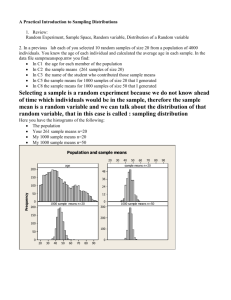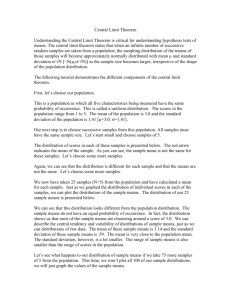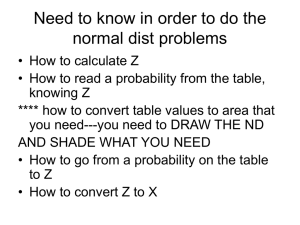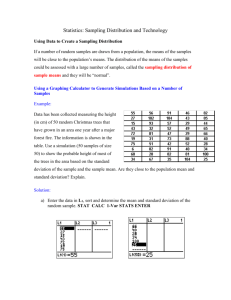Lecture Notes Dispersion and Distributions
advertisement
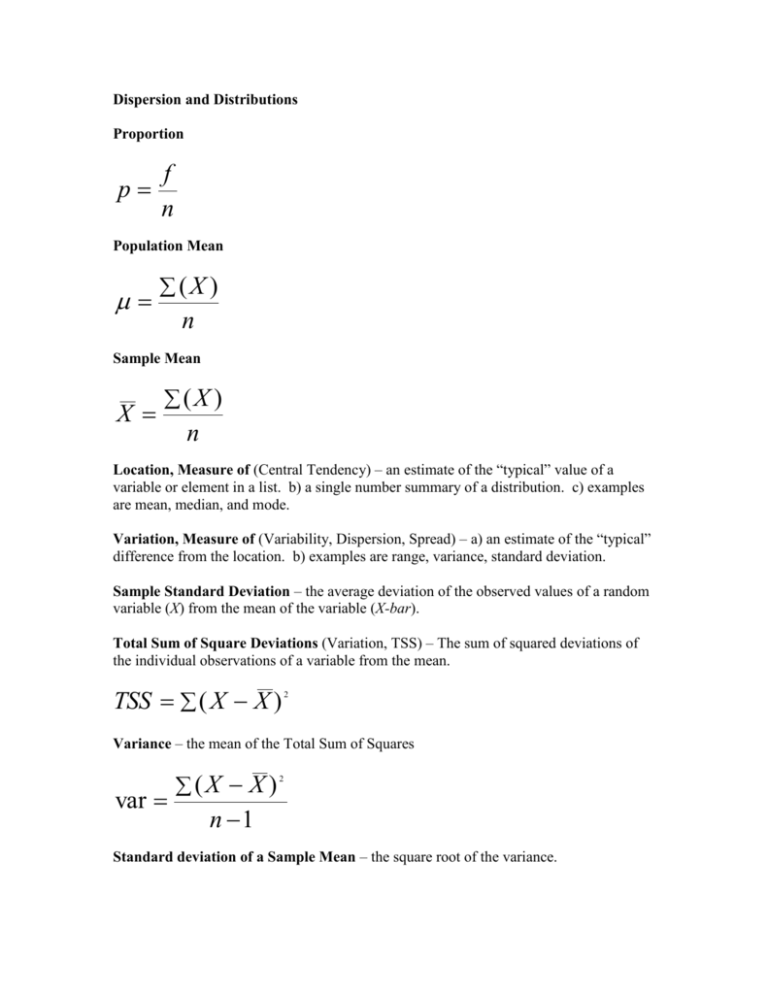
Dispersion and Distributions Proportion p f n Population Mean (X ) n Sample Mean X (X ) n Location, Measure of (Central Tendency) – an estimate of the “typical” value of a variable or element in a list. b) a single number summary of a distribution. c) examples are mean, median, and mode. Variation, Measure of (Variability, Dispersion, Spread) – a) an estimate of the “typical” difference from the location. b) examples are range, variance, standard deviation. Sample Standard Deviation – the average deviation of the observed values of a random variable (X) from the mean of the variable (X-bar). Total Sum of Square Deviations (Variation, TSS) – The sum of squared deviations of the individual observations of a variable from the mean. TSS ( X X ) 2 Variance – the mean of the Total Sum of Squares var (X X ) 2 n 1 Standard deviation of a Sample Mean – the square root of the variance. sd (X X ) 2 n 1 Standard deviation of a Sample Proportion – the square root of the variance but calculated as the square root of the probability (p) times the inverse of the probability (q=1-p). sd pq Population Standard Deviation – a) the average deviation of the population values of a random variable (X) from the mean of the variable (μ). b)like other population parameters is generally not known or observable. c) symoblied as sigma, like other population parameters a Greek letter. (X ) 2 N Normal Probability Distribution (Normal Curve, Gaussian Distribution, Bell Curve) – a) a bell shaped continuous probability distribution that describes data that cluster around the mean. b) is used as a simple model of complex phenomenon and is the basis of many inferential statistics. c) 68% of the observations are within one standard deviation of the mean, 5% of the observations are more than 1.96 standard deviations from the mean and 10% are more than 1.64 standard deviations from the mean. d) was formalized by Johann Carl Friedrich Gauss (1777-1855), a German mathematician, although he was not the first to conceptualize it. x N ( , ) Law of Large Numbers – a) in probability theory, a theorem that states that the average of the results obtained from a large number of trials should be close to the expected value. b) the mean from a large number of samples should be close to the population mean. c) the first fundamental theorem of probability. Central Limit Theorem – a) in probability theory, a theorem that states that the mean of a sufficiently large number of independent random trials, under certain common conditions, will be approximately normally distributed. b) as the sample size increases the distribution of the sample means approaches the normal distribution irrespective of the shape of the distribution of the variable. c) from a practical standpoint, many distributions can be approximated by the normal distribution, including the binomial (coin toss), Poisson (event counts), and Chi-Squared. d) justifies the approximation of large-sample statistics to the normal distribution. e) the first fundamental theorem of probability. Sampling Distribution – a) the distribution of a statistic, like a mean, for all possible samples of a given size. b) based on the law of large numbers and the central limit theorem, the sampling distribution will have a mean equal to the population mean and will be normally distributed. Standard Normal Probability Distribution (Z-distribution) – a) a normal probability distribution with mean 0 and variance/standard deviation 1. b) any other normal distribution can be regarded as a version of the standard normal distribution that has been shifted rightward or leftward to center on the actual mean and then stretched horizontally by a factor the standard deviation. x N (0,1) Z-Scores (Normal Deviates) – a standardized score that converts a variable (x) into a standard normal distribution with mean = 0 and sd =1 and a metric of standard deviations from the mean. X X z sd X ( z * sd ) X Student’s t-distribution – a) a probability distribution used for estimating the mean of a normally distributed population when the sample size is small, that is 50 or less. b) the overall shape of the t-distribution resembles the bell shape of the z-distribution with a mean of 0 and a standard deviation of 1, except that it is a bit lower at the peak with fatter tails. c) as the sample size increases, that is the number of degrees of freedom increase, the t-distribution more and more closely approximates the normal distribution, that is it asymptotically approaches normality. d) can be thought of not as a single distribution, like the z-distribution, but a family of distributions that vary according to the sample size, that is degrees of freedom. e) at a sample size of 50 (that is 49 degrees of freedom), 5% of the observations are more than 2.009 standard deviations from the mean (compared to 1.96 in the normal distribution) and 10% are more than 1.676 standard deviations from the mean (compared to 1.64 in the normal distribution).f) is generally the distribution used in estimating confidence intervals and inferential tests of the difference between sample means and sample means and hypothesized population means, instead of the zdistribution. g) was developed by William Sealy Gosset in his research aimed at selecting the most productive and consistent varieties of barley for brewing beer and was first published in 1908 using the pseudonym “Student” because his employer, the Guinness Brewery in Dublin, Ireland, prohibited its employees from publishing scientific research due to a previous disclosure of trade secrets by another employee. Standard Error - a) the standard deviation of a sampling distribution. b) a probabilistic estimate of the sampling error representing the spread or dispersion of the sample estimates. c) the part of the standard deviation of a variable that can be attributed to sampling variability, that is sampling error. se sd n

